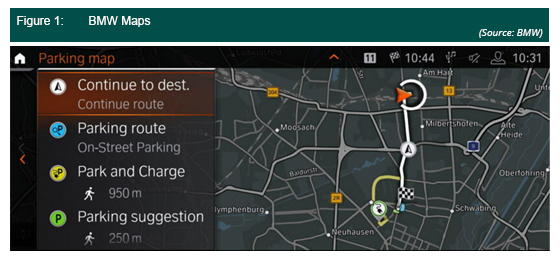3Q 2020 | IN-5872
Registered users can unlock up to five pieces of premium content each month.
BMW Introduces New Infotainment Features |
NEWS |
BMW 5 series mid-cycle refresh, which will be available in the 2021 5 Series, introduced key connected infotainment functions, including a cloud-based navigation system called BMW Maps. BMW Maps provides real-time traffic information, continual route updates, intuitive address input, precise route calculation, and higher accuracy. By using an anticipatory approach for navigation and route guidance, BMW Maps can adjust arrival time based on potential hazards and road congestion. The solution also provides available parking spaces at the destination and allows drivers to book and pay for parking (BMW On-Street Parking Information and Park Now).
 |
Additionally, BMW is finally offering Over-the-Air (OTA) upgrades for vehicles with BMW Operating System 7.0 and support for Android Auto. BMW has pioneered the launch of embedded cloud-based navigation, reinforcing its commitment to using connectivity and cloud applications to optimize the customer experience.
Cloud-Based Maps and Remote Updates |
IMPACT |
Built-in navigation systems have struggled to compete against navigation apps, such as Google Maps and Waze, due to sparse updates, low accuracy, lack of personalization, and poor interfaces. BMW Maps may be the innovation that will make drivers put their phones aside and car manufactures sit up and take notice. The new navigation technology offers address auto-completion, BMW assistant integration, points of interest with Yelp reviews, and broader coverage. Additionally, due to predictive traffic, the system has a better understanding of moving traffic, resulting in constant route updates and alternative routes options in real time. BMW Maps’ functionalities are not much different from what navigation apps after today, but it is groundbreaking when compared to other built-in navigation systems.
Eight years after Tesla introduced new functionality upgrades OTA in 2012, BMW now joins Cadillac and Porsche in the select group of traditional car Original Equipment Manufacturers (OEMs) currently offering remote software upgrades. The company's first update includes BMW Intelligent Personal Assistant, and subsequent versions will offer vehicle-specific content, function extensions, and new functionalities that can be activated via smartphone or inside the car itself. While OTA has the potential to improve User Experience (UX) and even brand loyalty, improved or additional functionalities require higher processing capacity. Thus, there is only so much one can add without a hardware upgrade. Tesla, for instance, faced persistent complaints from drivers of vehicles equipped with the company's first-generation Microcontroller Unit (MCU), equipped with NVIDIA's quad-core Tegra 3, because of systems slowdown and lack of support for video streaming and graphics-intense games. The company then started offering an infotainment hardware upgrade with its latest MCU, equipped with Intel's multi-core Atom E8000 processor, for US$2,500 to owners of Model S and Model X built March 2018 or earlier.
Connected Infotainment Moving Forward |
RECOMMENDATIONS |
Carmakers that want to maintain full control of the in-vehicle experience should adopt a similar approach to BMW Maps and offer built-in solutions that provide the same experience as smartphone apps, not only in terms of functionalities but also concerning OTA updates. However, OEMs offering remote software updates must be aware of their vehicles hardware limitations and have a clear approach for when the processing power of their vehicles starts getting obsolete. Unlike the smartphone industry, it is unlikely that drivers would upgrade their cars every two years. That is even more critical for mass-market OEMs that are known for using the cheapest hardware that can meet their functionalities requirements, leaving no headroom for further updates. Hardware upgrade could become a new revenue stream for OEMs. However, it would require a business model transformation.